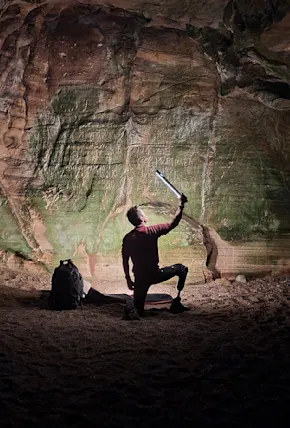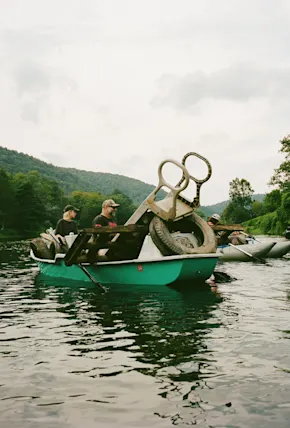But is what Davis makes purely sculputural? The answer is in the recently released Beachcomber Gear collection. Inspiration for the collection comes from the chaotic MacGyver method New Yorkers adopt on a beach day. "I was at the beach the other week and I saw someone with a fitted sheet and three sticks. And that was their sun protection," Davis shared.
This DIY behavior is characteristic of beach-goers (myself included), and Davis mused that city-dwellers simply don't have the capacity for storing an entire beach set in a tiny apartment. The collection seeks to act as both an homage to and counteraction against such behavior, with objects that transition between the coast and downtown.
For instance, there's the collection's pièce de résistance, the inflatable Seatpack ($595), a creation that's half flotation device, half beach chair. The chair features a two-stage Boston valve for inflation and deflation, adjustable nylon and brass support straps, a leather carrying handle, and a clever fabric anchor that doubles as a storage pouch. Davis believes the Seatpack could also be beanbag-esque chair in a hip LES living room or a Bed-Stuy studio.
The Beachcomber collection also includes bags ranging from the Periwinkle crossbody ($135) to the Conch tote ($225), that transition between city and seacoast. Their high-quality water-beading mesh with forest-green straps and brass finishings is opaque enough to obscure possessions in city streets, but you can also run it under water to rinse off sand. Each bag includes surprising details like a vintage dry cup for protecting a phone (or making sandcastles) and a pair of little scissors for cutting fishing line.
The collection is rounded out with the Keepsake Hat ($95), the Slingshot Sunglasses ($225), Spotter Sunglasses ($225), and the Striped Sea Oat Shorts ($135). These items may take a back seat to the more showy Seatpack and Beachcomber bags, but they're by no means less imaginative. For instance, the Slingshot Sunglasses, made of restored vintage frames with new amber lenses, feature a floating strap that doubles as a slingshot rig.
Lastly, there's a Field Identification Guide ($10), a waterproof pamphlet featuring hand-drawn illustrations of common wildlife found at Far Rockaway, Queens, and quick field references for tying a variety of fishing knots.














